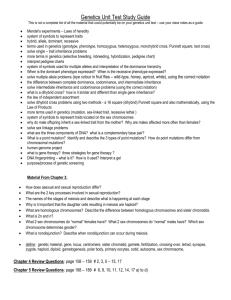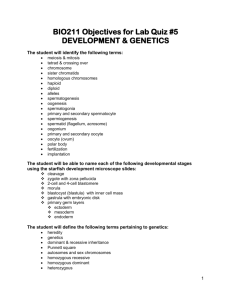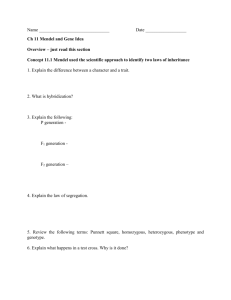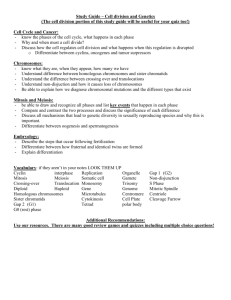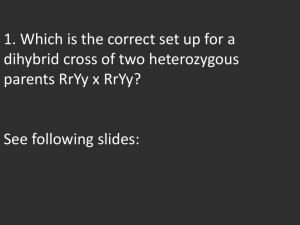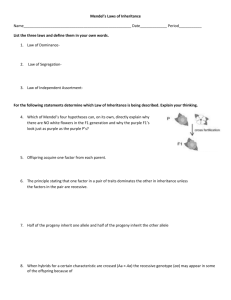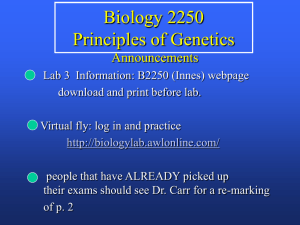Genetics --- introduction
advertisement
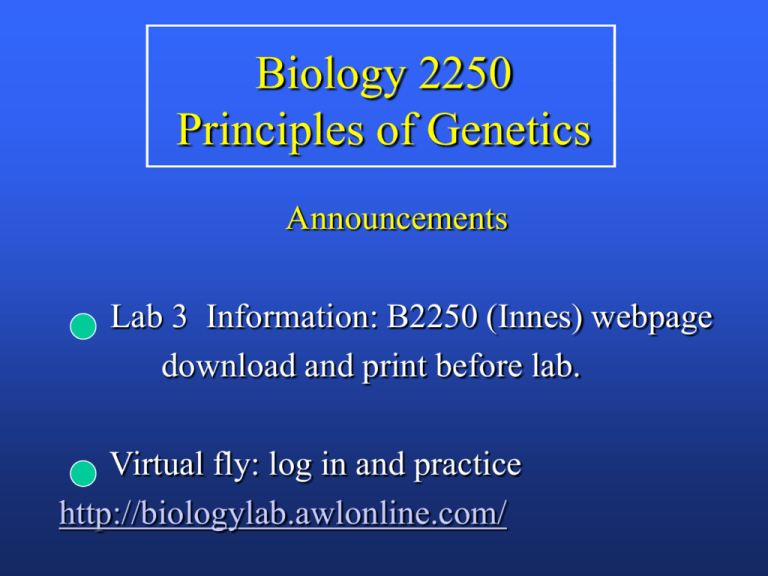
Biology 2250 Principles of Genetics Announcements Lab 3 Information: B2250 (Innes) webpage download and print before lab. Virtual fly: log in and practice http://biologylab.awlonline.com/ Weekly Online Quizzes Marks Oct. 14 - Oct. 22 Example Quiz 2** for logging in Oct. 21- Oct. 24 Quiz 1 2 Oct. 28 Quiz 2 2 Nov. 4 Quiz 3 2 Nov. 10 Quiz 4 2 B2250 Readings and Problems Ch. 4 p. 100 – 112 Ch. 5 p. 118 – 129 Ch. 6 p. 148 – 165 Prob: 10, 11, 12, 18, 19 Prob: 1 – 3, 5, 6, 7, 8, 9 Prob: 1, 2, 3, 10 Mendelian Genetics Topics: -Transmission of DNA during cell division Mitosis and Meiosis - Segregation - Sex linkage (problem: how to get a white-eyed female) - Inheritance and probability - Independent Assortment - Mendelian genetics in humans - Linkage - Gene mapping - Tetrad Analysis (mapping in fungi) - Extensions to Mendelian Genetics - Gene mutation - Chromosome mutation - Quantitative and population genetics Sex-linked Inheritance Correlation between inheritance of genes and sex Drosophila melanogaster (T. H. Morgan) White eye (mutant) Red eye (wild) X Drosophila Red Eye White eye Cross A red female F1 F2 No whiteeyed females X white male all red red : white 3 : 1 white all male red 2 : 1 female : male How to obtain a white-eyed female? Cross B white female F1 X females F2 red male males females 1 :1 males : 1 :1 Cross A Xw+Xw+ w+w+ ww+ F1 ww+ X X Xw Y wY w+Y wY w w+ w ww ww+ Y wY w+Y Mendelian Inheritance Determining mode of inheritance: - single gene or more complicated - recessive or dominant - sex linked or autosomal Approach: cross parents observed progeny compare with expected Principle of Segregation Implications Answer questions on inheritance: - mode of inheritance (dominant, recessive sex-linked) - paternity - hybridization Mendel’s First Law Equal segregation of two members of a gene pair ½ A gametes Meiosis: diploid nucleus divides Aa ½ a gametes produces haploid nuclei P(a) = ½ P(A) = ½ Rules of Probability 1. Product rule (AND): probability of 2 independent events occurring simultaneously 2. Sum Rule (OR): probability of either one of two mutually exclusive events Probability 1. **Coin toss: P (T) = P(H) = 1/2 P(T, T, T) = P(T) and P(T) and P(T) = (½)3 = ½ x ½ x ½ 2. One die: P (6) or P (5) = 1/6 + 1/6 **http://shazam.econ.ubc.ca/flip/ Self F1 F2 eggs Aa X Aa equal Segregation P(A) = ½ P(a) = ½ sperm 1/2 A 1/2 a 1/2 A 1/4 AA 1/4 Aa 1/2 a 1/4 Aa 1/4 aa Prob. (AA or Aa) = 1/4 + 2/4 = ¾ Prob. (aa) = ¼ P(AA) = ½ * ½ Two Characters Monohybrid Cross parents differ for a single character (single gene ); seed shape Dihybrid Cross parents differ for two characteristics (two genes) Dihybrid Two Characters: 1. Seed colour yellow green Y y 2. Seed shape Round wrinkled R r 4 phenotypes Dihybrid P RRyy Gametes F1 X Ry rrYY rY RrYy DIHYBRID F1 Dihybrid ----->F2 F1 RrYy RrYy F2 9 3 3 1 Total 315 108 101 32 556 X RrYy round, yellow round, green wrinkled, yellow wrinkled, green Individual Characters 1. Seed shape round : wrinkled 423 : 133 3: 1 (¾ : ¼) 2. Seed colour yellow : green 416 : 140 3 : 1 Conclusion * 3 : 1 monohybrid ratio for each character * 9 : 3 : 3 : 1 phenotypic ratio a random combination of 2 independent 3:1 ratios Two Independent Genes F2 colour yellow 3/4 green 1/4 seed shape 3/4 1/4 round wrinkled 9/16 3/16 3/16 F2 1/16 Phenotypes Applying Probability to Genetics Dihybrid: RrYy Hypothesis: mechanism for putting R or r into a gamete is independent of the mechanism for putting Y or y into a gamete Gametes from Dihybrid Dihybrid: RrYy (F1) Principle of segregation during gamete formation: Yy -------> P(Y) = P(y) = 1/2 Rr ------->P(R) = P(r) = 1/2 Gametes from dihybrid RrYy : Y and R Y and r y and R y and r probability 1/2 * 1/2 = ¼ 1/2 * 1/2 = ¼ 1/2 * 1/2 = ¼ 1/2 * 1/2 = ¼ 4 gamete types YR Yr yR yr F1 gametes produce F2 F1 YyRr X ¼ YR ¼ YR gametes Yr yR yr YyRr gametes Yr yR yr 1/16 RRYY F2 Sperm F2 Fig. 6-7 Eggs F2 4 Gametes 9 Genotypes 4 Phenotypes Mendel’s Second Law Independent assortment: during gamete formation, the segregation of one gene pair is independent of other gene pairs. (Genes) Meiosis I A Correlation of genes and Chromosomes during Meiosis I a A B A b OR a b a B Producing the F2 F1 YyRr F2 X YyRr 1. F1 Gametes produce F2 2. Genotypes 3. Phenotypes Independent Assortment Two gene systems: 1. Gametes from dihybrid 4 x 4 = 16 YyRr: Male gametes ¼ YR Yr yR yr ¼ YR 1/16YYRR Female Yr F2 gametes yR yr Independent Assortment 2. F2 Genotypes 3 x 3 = 9 YyRr X YyRr ¼ RR ¼ YY ½ Yy ¼ yy ½ Rr 1/16 YYRR F2 ¼ rr Independent Assortment 3. F2 Phenotypes 2 x 2 = 4 YyRr X YyRr ¾ Y¼ yy ¾ R- ¼ rr 9/16 R-Y- F1 YyRr x YyRr YY RR YY Rr Yy RR Yy Rr Y-R- YY rr Yy rr Y-rr yy RR yy Rr yyRyyrr yy rr 9 Genotypes 4 phenotypes Independent Assortment F1 F2 AaBb 9 3 3 1 X A-BA-bb aaBaabb AaBb 4 phenotypes Independent Assortment Test Cross AaBb X gametes ab 1/4 AB AaBb 1/4 Ab Aabb 1/4 aB aaBb 1/4 ab aabb aabb 4 phenotypes 4 genotypes Independent Assortment Inferred F1 gamete types Fig 6-6 AB ab Ab aB Interchromosomal Recombination Independent Assortment Any number of independent genes: Genes 1 2 3 n Phenotypes 2 4 8 2n Genotypes 3 9 27 3n Mendelian Genetics in Humans Determining mode of inheritance Problems: 1. long generation time 2. can not control mating Alternative: * information from matings that have already occurred “Pedigree” Human Pedigrees Pedigree analysis: • • • trace inheritance of disease or condition provide clues for mode of inheritance (dominant vs. recessive) (autosomal vs. sex linked) however, some pedigrees ambiguous Human Pedigrees 1. Ambiguous: Affected female Normal male 2. Unambiguous: Normal female Clues (non sex-linked) Recessive: 1. individual expressing trait has two normal parents 2. two affected parents can not have an unaffected child. Rare Recessive Rare = AA A(AA or Aa) Cousins (inbreeding) Clues Dominant: 1. every affected person has at least one affected parent 2. each generation will have affected individuals Dominant Not AA All genotypes known Examples Recessive: - phenylketonuria (PKU) - hemophilia (sex linked) - cystic fibrosis - albinism Dominant: - huntingtons chorea - brachydactyly (short fingers) - polydactyly (extra fingers) - achondroblasia (dwarf) http://www.ncbi.nlm.nih.gov/entrez/query.fcgi?db=OMIM Brachydactyly Bb bb Bb short fingers bb normal Online Tutorial: http://www.biology.arizona.edu/mendelian_genetics/mende lian_genetics.html Solving Genetics Problems 1. Don’t panic! 2. Carefully read the problem 3. What information is given? Know the terms used. 4. What aspect of genetics does the problem address? Sex Linked Inheritance X-linked Dominant 1. affected male ---> all daughters affected no sons aa x AY ----> Aa, aY 2. affected female ----> ½ sons, ½ daughters affected Aa x aY ----> AY, aY, aa, Aa * * X-Linked Dominant 1. All daughters affected, no sons 2. 1/2 daughters affected, 1/2 sons affected X-linked Inheritance X-linked recessive: 1. more males than females show recessive phenotype 2. affected female ------> both mother and father have recessive allele A a x a Y --------> a a X-linked Inheritance X-linked recessive: 3. affected male ----> mother carries allele A a x AY -----> a Y carrier 4. affected male -----> no affected offspring AA x a Y ----> AY, Aa carrier X-Linked Recessive Mother carrier Sex Linked Inheritance (examples) X linked genes Humans: - colour blindness - hemophilia • • More common in males (hemizygous aY) X linked recessives expressed Queen Victoria (carrier) QE II Hemophilic male Carrier female X-linked recessive hemophilia X – linked disease genes Mendelian Genetics Topics: -Transmission of DNA during cell division Mitosis and Meiosis - Segregation (Monohybrid) - Sex linkage - Inheritance and probability - Independent Assortment (Dihybrid) - Mendelian genetics in humans (Pedigree)
